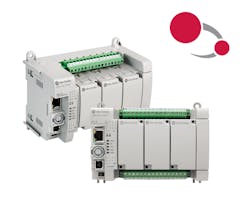Rockwell Automation’s AB Micro850 and Micro870 PLC Systems Provide Connectivity, Design Efficiency
Rockwell Automation expanded the capabilities of its Micro850 and Micro870 PLC systems to offer more connectivity, simple integration to PowerFlex 520 series and Kinetix 5100 drives via predefined tags, and easy programming to drives with the use of Connected Components Workbench software version 21 or later.
Key features of the Micro850 and Micro870 PLC systems include:
- improved performance with increased I/O response and code execution time
- increased protocol connectivity with additional DNP3 (Micro 870 only) and expanded DF1 communications support
- easy recognition of new controller options with catalog numbers containing E, for Ethernet connectivity, after the controller series (e.g., 2080-L50E)
- operates in -20…+65 °C (-4…+149 °F) temperatures
- supports microSD card for program transfer, datalog and recipe management through plug-in module.
READ MORE: Design Insights: Building a Better PLC; Component Selection in Medical Equipment | Machine Design
Minimize Programming and Troubleshooting Time
Allen-Bradley Micro850 and Micro870 controllers offer greater connectivity and design efficiency through the Class 1 implicit messaging capability with up to eight EtherNet/IP devices supported, according to the company. Other benefits include easy programming and simpler workflow through a familiar and intuitive design environment.
Connected Components Workbench software version 21 is the required minimum to support the Class 1 implicit messaging capability in the PLCs. Controller and software enhancements can help drive industrial operations productivity while lowering costs, according to Rockwell Automation.
Additionally, users can minimize programmatic efforts and troubleshooting time, which simplifies the development of standalone machines. Expanded smart capabilities allow automation projects to be developed and deployed faster, which can accelerate time to market and drive business growth.
About the Author
Sharon Spielman
Technical Editor, Machine Design
As Machine Design’s technical editor, Sharon Spielman produces content for the brand’s focus audience—design and multidisciplinary engineers. Her beat includes 3D printing/CAD; mechanical and motion systems, with an emphasis on pneumatics and linear motion; automation; robotics; and CNC machining.
Spielman has more than three decades of experience as a writer and editor for a range of B2B brands, including those that cover machine design; electrical design and manufacturing; interconnection technology; food and beverage manufacturing; process heating and cooling; finishing; and package converting.
Email: [email protected]
LinkedIn: @sharonspielman
Facebook: Machine Design
YouTube: @MachineDesign-EBM

